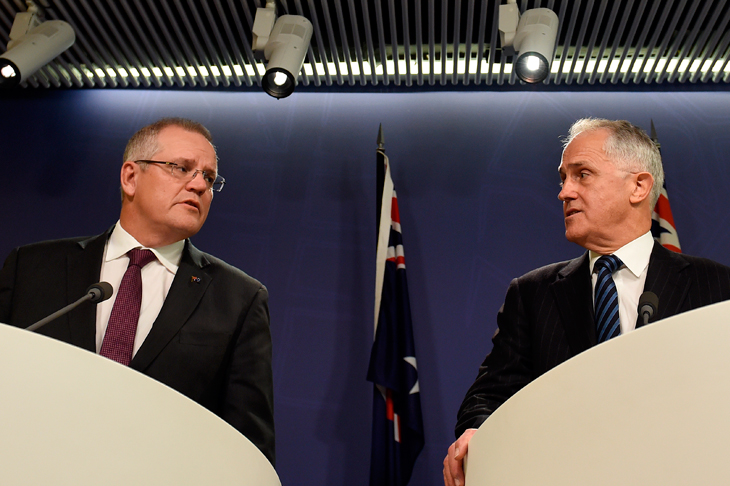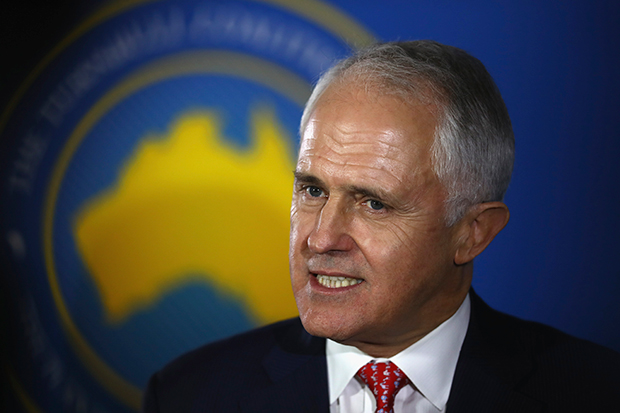Stealing Shorten’s shorts
In 1845 Benjamin Disraeli said of Britain’s Tory Prime Minister, Sir Robert Peel, that he had ‘caught the Whigs bathing and ran off with their clothes’. Malcolm Turnbull’s and Treasurer Scott Morrison’s 2017-18 budget seems likewise to have left Bill Shorten naked. With millions of words already uttered about the details of that astonishing performance, its sheer effrontery is still sinking in, and its consequences for the Liberal Party’s future have barely begun to be comprehended. Rather than further tilling that ground, this article considers three general aspects – the proposed tax on our five biggest banks; Morrison’s new emphasis on ‘operating balance’ as his preferred yardstick for judging the budget’s quality; and its disastrous political impact for the Liberals.
The new tax (0.06 per cent on their assessed liabilities) on the ‘big four’ banks plus Macquarie not only infringes almost every taxation policy principle, but also carries more sinister overtones. As has been said, it is the kind of measure one associates with those havens of fiscal responsibility and attractiveness to foreign investors, Venezuela or Zimbabwe. Think about it as the Goods and Services Tax increase you have when you’re not having a GST increase – even better from the federal government’s viewpoint because, unlike a GST increase, it doesn’t have to transfer the proceeds to the States.
Why the new tax (which, incidentally, is a tax, not a ‘levy’, as Morrison has labeled it) can be so viewed is because it will end up being borne not by the banks, but by others – their customers (higher interest rates for borrowers, or lower interest rates for depositors); their shareholders, including superannuation funds holding their shares; all those superannuation funds’ members; and their employees. So, one way or the other, this will end up not as a measure hitting a few big banks, but one (just like the GST) imposed on a wide cross-section of the general public. Recall that in late 2015 Morrison (urged on by Turnbull) publicly canvassed raising the GST rate. By early 2016, however, facing the storm of protest this thought bubble had produced, Turnbull (not for the last time) cut him adrift and abandoned any thought of increasing the GST. Compare that debacle with the current proposal, which gives the government $6.2 billion in new revenues over the next four financial years by appearing to impose a tax on those unloved creatures, banks (and even then, ‘only’ the big ones). Perfect!
So perfect, in fact, two consequential thoughts immediately arise. What if, instead of levying this tax at 0.06 per cent, the government were to double it to 0.12 per cent? – or even 0.18 per cent? Think of all the extra spending, or even those long-promised but ever-receding tax cuts, that new revenue stream could then finance. Why, some of it could even help to reduce the deficit. Secondly, why stop at banks? Just find another industry dominated by large unpopular firms and you can do it again. Do Coles and Woolworths come to mind?
In this budget Morrison also attempted a new sleight of hand. Budget papers have previously featured two measures of the fiscal situation, the ‘underlying cash balance’ and the ‘fiscal balance’. (The latter has always been useless, and commentators have invariably focused on the former; significant accounting resources could be saved by ceasing to calculate the fiscal balance entirely). Last week’s budget, while still presenting the underlying cash balance up front, relegated the fiscal balance to later detailed tables and gave prominence instead to the ‘operating balance’. This figure has long been available, deep in the budget documents, but now Morrison seeks to give it pride of place because, he says, it indicates when ‘the government will no longer be borrowing to pay for our everyday expenses’ – with that ephemeral surplus emerging in 2019-20, rather than 2020-21 on the underlying cash balance basis. This is all tied up with his distinction between ‘good debt’ and ‘bad debt’ – a distinction without a difference so far as the interest payments, and repayment liabilities, deriving from both forms of debt are concerned. However, now Morrison has sought thus to spin his figures, we should really focus not on his operating balance figure, but on the much better measure of where all his borrowing is leading, namely the ‘headline balance’. This includes all Commonwealth spending, including that deriving from borrowings to finance such ‘off-budget’ entities as the NBN Co. Since the government’s new infrastructure push will put more spending off-budget, the best measure of its fecklessness will be found not in the operating balance, or even in the underlying cash balance (better though that remains), but in the headline balance.
To illustrate, in 2019-20 (say), the budget papers project a net operating surplus of $7.6 billion, while the underlying cash balance is projected at a $2.5 billion deficit. The headline cash balance, however, is projected more realistically at a deficit of $14.8 billion. (All these out-year figures are largely meaningless in any case, but let that pass).
More fundamentally, the consequences of this massive philosophical U-turn for the Liberal Party (and also for the Nationals) are incalculable. Most observers expected a ‘sugar hit’ for the Coalition in the polls. Since that was clearly the aim to which this travesty of everything Menzies’ party was supposed to stand for was directed, they needed at least to be right about that. But as Monday’s Newspoll showed, they weren’t, with the Coalition primary vote unchanged on 36 per cent and its two-party preferred vote actually falling a point. Even if future polls were to improve somewhat (which they won’t), that wouldn’t ward off this budget’s destabilising effects. Anyone for the Australian Conservatives Party?
Got something to add? Join the discussion and comment below.
Get 10 issues for just $10
Subscribe to The Spectator Australia today for the next 10 magazine issues, plus full online access, for just $10.
You might disagree with half of it, but you’ll enjoy reading all of it. Try your first month for free, then just $2 a week for the remainder of your first year.














Comments
Don't miss out
Join the conversation with other Spectator Australia readers. Subscribe to leave a comment.
SUBSCRIBEAlready a subscriber? Log in